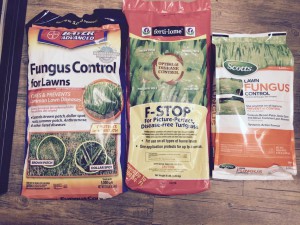 Lawn fungus, such as Brown Patch Disease, is one by-product of too much moisture combined with warmer weather. To avoid disaster especially with new Spring lawn growth, Texas A & M Agri-Life Extension recommends a consistent application of a fungicide to your lawn, particularly if your lawn is showing symptoms of on-set disease.
Lawn fungus, such as Brown Patch Disease, is one by-product of too much moisture combined with warmer weather. To avoid disaster especially with new Spring lawn growth, Texas A & M Agri-Life Extension recommends a consistent application of a fungicide to your lawn, particularly if your lawn is showing symptoms of on-set disease.
New Braunfels Feed & Supply recommends products like Bayer Fungus Control for Lawns, Fertilome F-Stop and Scotts Lawn Fungus Control.
Warm-season grasses such as St. Augustine (especially the over-planted ‘Raleigh’ selection), Bermuda, and Zoysia are most commonly affected by brown patch (also called large patch) during the early spring and late fall.
Symptoms
Symptoms of brown patch may vary greatly with the type of grass and soil conditions. The disease usually causes thinned patches of light brown grass that are roughly circular in shape. These areas range in diameter from a few inches to several feet. Often the center of the patch will recover, resulting in a doughnut-shaped pattern.
When disease conditions are favorable, large areas of the lawn may be uniformly thinned and eventually killed with no circular patch being evident. This type of pattern is commonly seen on infected St. Augustine grass grown in shady, moist locations.
Close inspection of grass blades reveals small, irregular, tan leaf spots (burnt cigarette appearance) with dark-brown borders in combination of rotted leaf sheaths near the soil surface.
Grasses Commonly Affected
There are no turfgrass species currently available that are entirely resistant to brown patch. Brown patch is the most common and important disease of ‘Raleigh’ St. Augustine in our area. In most cases, affected areas are able to recover, but the selection of Flora-TAM (St. Augustine) shows the most potential for being highly resistant.
Prevention and Treatment
The best way to prevent brown patch in the home lawn is by following good lawn care practices. This is much easier and less expensive than continued use of fungicides and can be very effective.
Avoid high nitrogen rates on warm season grasses in mid to late fall. The brown patch fungus readily attacks the lush growth of grass which nitrogen promotes. The use of Texas greensand as a supplement when fertilizing will help adjust the soil pH, thus making essential nutrients readily available. Apply Texas greensand at a rate of 10 pounds per 1000 square feet.
Irrigate grass only when needed and to a depth of 4 to 6 inches. Water early in the morning. This disease can spread fast when free moisture is present.
Avoid spreading the disease to other areas. Remove clippings if the weather is warm and moist to prevent spread to other areas during mowing.
Keep lawns mowed on a regular basis to the proper height for the grass species you are growing. Prevent excessive thatch buildup.
Provide good drainage for both surface and subsurface areas.
Fungicides can be difficult to rely upon for controlling brown patch in the home lawn, but regular applications can vastly improve appearance. A good rule of thumb to follow on warm-season grasses is to initiate fungicide sprays when nighttime low temperatures reach 70° F. Stop applications when nighttime lows are forecast to be below 70° F for five consecutive days. Typically, applications are made at 14-day intervals. Stop by New Braunfels Feed & Supply for all your lawn and garden needs.